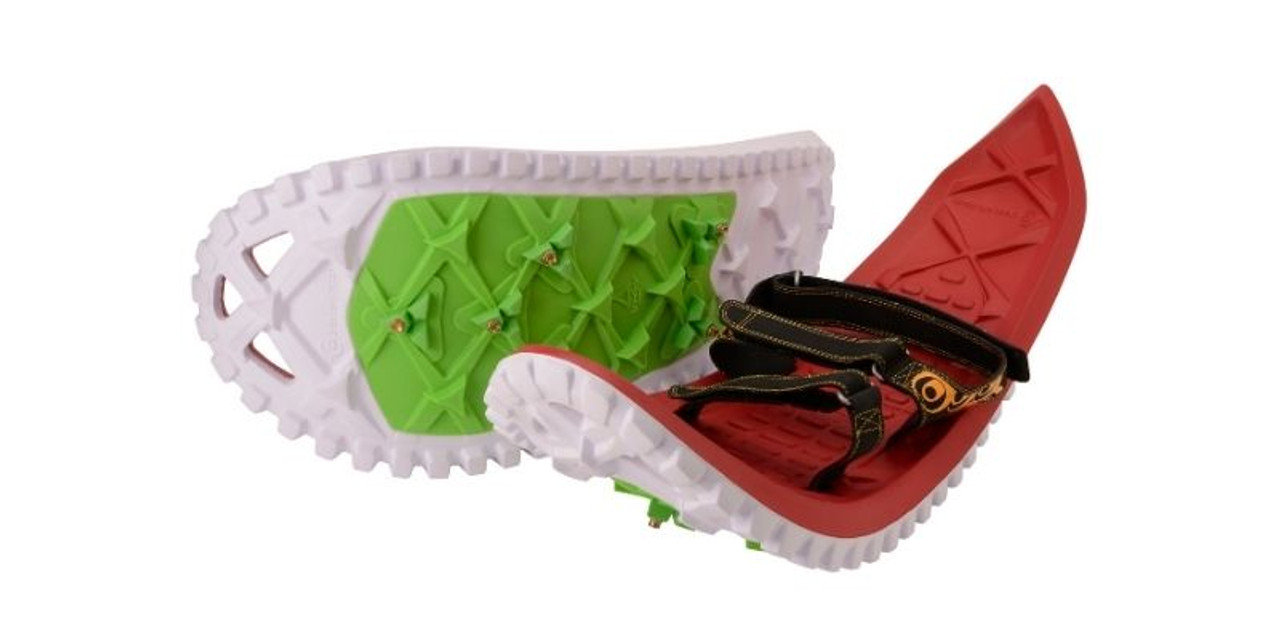Anatomy of Snowshoes
Posted by Crescent Moon on Jan 27th 2020
If you try to walk through a few meters of freshly fallen snow in boots or tennis shoes then your feet will sink through the snow. However, if you were to strap on a pair of snowshoes, you could easily do this thanks to the physics of snowshoes. Crescent moon foam snowshoes work amazingly well for your snowy adventuring. Lets look at the anatomy of a snowshoe and how they work to keep you from sinking in to the snow.
How Do Snowshoes Work?
Snowshoes work by having a larger surface area than the bottom of your tennis shoe or boot. The larger surface area means you have more snow supporting your body weight from below than when you wear a regular shoe. The extra surface area helps distribute the weight coming down on the snow from above. The snowshoe maximizes a measurement known as PSI, or pounds per square inch. With a regular boot, there is a lot of body weight that is distributed over just a few inches. With a snowshoe, the body weight is distributed out over many more inches. This is also why one pair of snowshoes doesn’t fit everyone. Heavier individuals or those with larger packs of supplies need bigger snowshoes. Lighter people don’t push as much pressure on the snow to begin with so they can use a smaller pair.
Snow conditions also matter when it comes to how snowshoes keep you from sinking. Packed snow can take more pressure than new, fresh fallen, and fluffy snow.
The Design of the Snowshoe
Snowshoes have different aspects that work when you use them. If you are just going by the simple laws of physics to not sink in the snow then you could technically use a piece of plywood.
Snowshoe Frame
The frame gives the snowshoe its structure and shape. With Crescent Moon Eva snowshoes, the frame is made of an expandable polymer or foam. It’s the same material that is used in athletic and running shoes throughout the world to create a more comfortable experience.
Snowshoe Deck
The deck is what makes up the surface area the snowshoe gives. The deck helps disperse your weight across the surface and works together with the frame. The decking can be described as the ski and the frame is the bones.
Snowshoe Cleats/Crampons
The cleats or crampons are used for icy conditions. You may have experienced trying to get across a patch of ice in regular snow boots. You can feel like you have no control and won’t make it to the other side. However, if you have metal pointed teeth at the bottom that dig into the ice when you take a step, you can feel more confident about getting across the ice. This is exactly what the cleats are designed for on a snowshoe. If the snow you are going across in your snowshoes is fresh then you may not need these, but these help provide traction and keep you from slipping.
Snowshoe Binding
The binding helps keep your snowshoes strapped on so your boots aren’t slipping out. The Eva snowshoes have simple, secure hook-and-loop bindings to keep your foot firmly planted. This will allow you to easily walk in the snowshoe.
Snowshoe Nose
The nose of the snowshoe is the front. It’s typically curved upwards, similar to what you would see on a ski. This is so when you take a step, the snow stays under the snowshoe instead of the front scooping up the snow like a shovel. This makes snowshoeing much less of a hassle. The snow weighing down the front half of a snowshoe would cause excess energy to be used up. The odds of tripping would be higher if you didn’t have a nose that flips up.
Snowshoe Tail
The tail is similar to the nose. The tail is usually skinnier than the middle section and the nose. This is due to the stride most people have when they walk.
Not every snowshoe is going to be created equal. Traditional snowshoes can be awkward and heavy and with each step, you have an unnatural hesitation. Traditional snowshoes can also drag on the ground or catch with a weird slapping noise. This doesn’t happen with a foam snowshoe, which creates a much quieter experience than a traditional shoe.
What to Do if You Are Still Sinking in Your Snowshoes
If you are still sinking into the snow despite your snowshoes, you may have the wrong size or the wrong shoes for your conditions. Remember that fluffy snow may require a bigger snowshoe. Be sure the snowshoes are rated for your weight. Once you find the perfect pair, let your winter snowshoe adventures begin!
